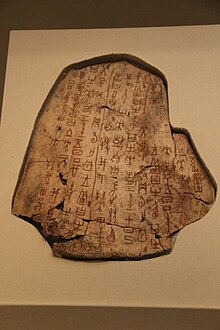
The second royal regime of China, the Shang dynasty (c. 1600 - 1046 BCE), developed a polytheistic religion that focused on worshipping spiritual beings.[2] The dynasty developed a bureaucracy specialized in practicing rituals, divided into several positions tasked with performing different aspects of the religion.[3][4] Usually, the head practitioners were the Shang king and other members of the royal family.[3] Their activities, taking place at the Shang dynasty's capital city Yin, were recorded on oracle bones. The Shang religion also existed outside of the capital, being practiced by royal patrons who were entrusted to govern different regions within the Shang state.
Since c. 1250 BCE, the first instances of recorded rituals have been documented by the Shang people. Various positions were employed to either directly practice the religion or to provide related support. The involvement of shamans in the Shang religion is under debate. Researchers such as K. C. Chang support the view of active shamans in the court,[5] while others claim that the dynasty did not actually adopted shamanism in ceremonies. In particular situations, the Shang king and royal members acted in a shamanic way when hosting rituals.